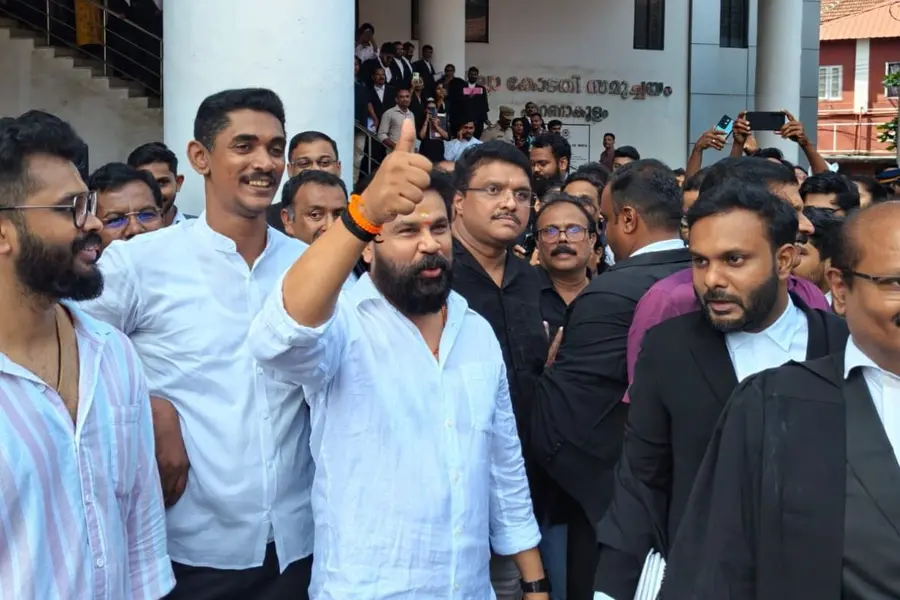“There is no transparency while distributing the ration. The Anganwadi officials give us the ration and make us sign the receiving, but we cannot see the ration measure or keep a record in our register. Some beneficiaries get less than what they are entitled to under the scheme, while others have received ration more than once. We want transparency and accountability in the process. We want the DM to look into the matter and conduct an inspection,” says Savitri Devi, the President of the Pavan Mahila Block Sangathan speaking at a dharna on March 17, 2021.
Savitri Devi from Bhaila Makdumpur Gram Panchayat was accompanied by 350 other women from Manjhapur block in Kaushambi district of Uttar Pradesh for the dharna. The women are members of the Pavan Mahila Block Sangathan, a federation of women’s self-help groups. On the scheduled day for the dharna, they had wrapped up their morning chores early and arranged tractors to commute the 15-kilometer distance to the District Collectorate office in Kaushambi.
Upon reaching, they occupied the courtyard of the Collectorate and insisted on speaking to the District Magistrate. They were there to demand transparency in the distribution of take-home rations by the Anganwadi Kendras in their block.
“We met the DM, Shri Amit Kumar Singh ji, and also submitted a written complaint. However, he diverted the conversation and instead started talking about other things like pension, loans, employment,” says Savitri Devi.
The ‘Take-Home Ration’ scheme
In September 2020, the UPSRLM signed a Memorandum of Understanding with the UN World Food Programme for the manufacture and supply of ‘take-home ration’ through women’s self-help groups.
The scheme was initially started in 18 districts (Aligarh, Ambedkarnagar, Auraiya, Baghpat, Banda, Bijnor, Chadauli, Etawah, Fatehpur, Gorakhpur, Kannauj, Kheri, Lucknow, Mainpuri, Mirzapur, Prayagraj, Sultanpur, and Unnao) and has now extended to all 75 districts of Uttar Pradesh.

The objective of the scheme is to improve the livelihood of self-help group members while fulfilling the food requirements prescribed under the Integrated Child Development Services (ICDS). This is significant, as Uttar Pradesh has one of the highest malnutrition levels in the country. The scheme is also expected to generate an additional income of INR 4800 – INR 6000 per month for the self-help group members and is to be distributed by SRLM-mapped self-help groups to prevent irregularities.
“The take-home ration includes good quality grains, pulses, ghee, and milk which are extremely beneficial for the health of women and children. In reality, however, there are irregularities in the distribution of ration due to a lack of proper monitoring. By involving self-help group members, ASHA, and Anganwadi workers, we can ensure that the right beneficiaries are able to avail the scheme along with correct information about breastfeeding and other practices to beat malnutrition,” says Krishna Kumar, a public health expert with 14 years of experience in the field.
As per a circular (attached below) issued by the Uttar Pradesh State Rural Livelihood Mission (UPSRLM) on 3rd November 2020, and more recently on 23rd March 2021, take-home dry ration is to be distributed to eligible families through Self-Help Groups in all 75 districts of Uttar Pradesh.
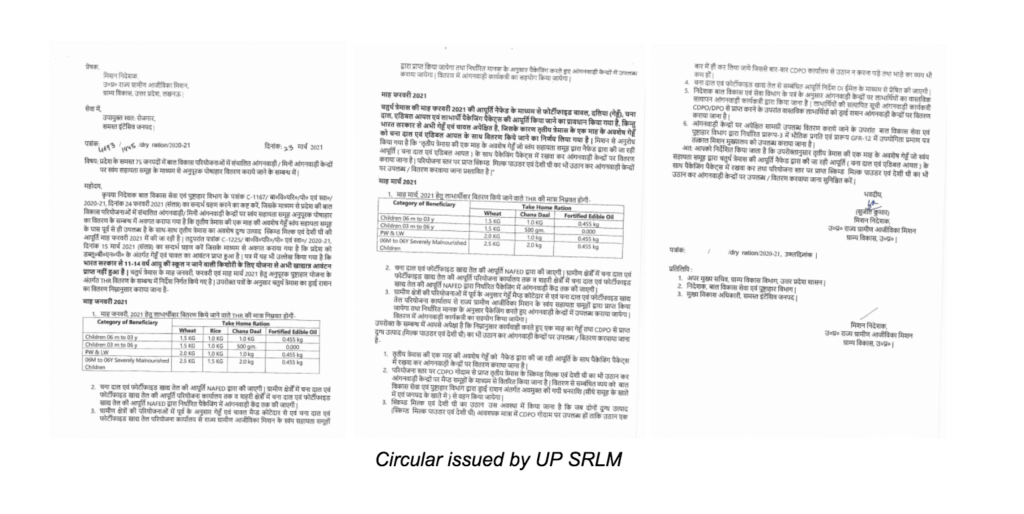
Women with children aged six months to three years are entitled to 1.5 kg wheat, 1 kg rice, 1 kg chana dal, and 0.45 kg fortified edible oil every month. Severely malnourished children between the ages of six months to six years are entitled to 2.5 kg wheat, 1.5 kg rice, 2 kg chana dal, and 0.45 kg of fortified edible oil every month. Similarly, there are other categories of beneficiaries mentioned in the circular.
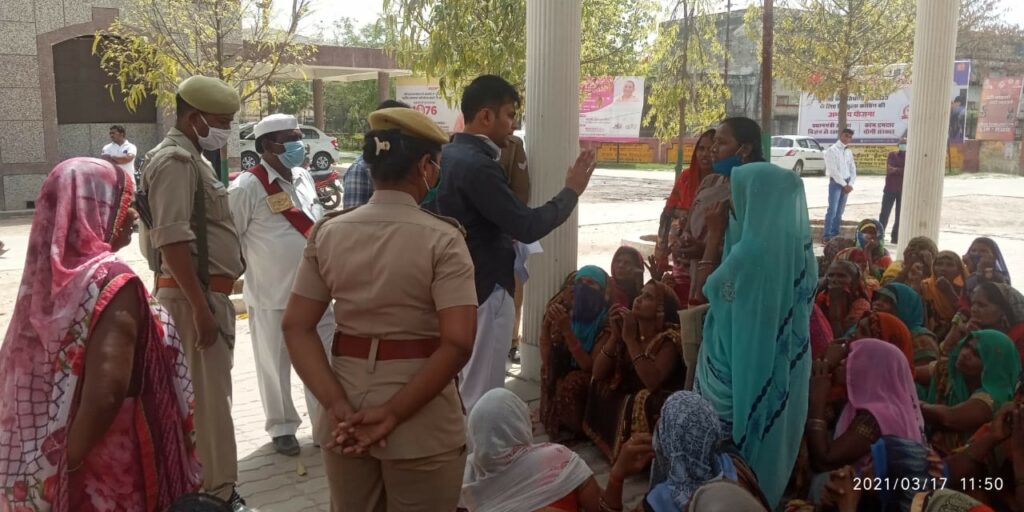
“A few days after the dharna, I was allowed to distribute the remaining ration equitably amongst the eligible beneficiaries in Bhaila Makdumpur Gram Panchayat. However, soon after, the Chief Development Project (CDPO) Manju and Anganwadi Supervisor Pushpa Singh told us that self-help groups have no role to play in the distribution of ration. She wanted us to sign the receiving whether they or not the ration is distributed to beneficiaries. There are three Anganwadi workers in this gram panchayat and they were trying to give ration to the same beneficiaries three to four times while others hadn’t received any grains. I asked them where this ration had gone, to which the Supervisor said that how the ration is distributed is none of our business. After we complained to the DM, she threatened to send us to jail and get our self-help groups shut down,” says Savitri Devi.
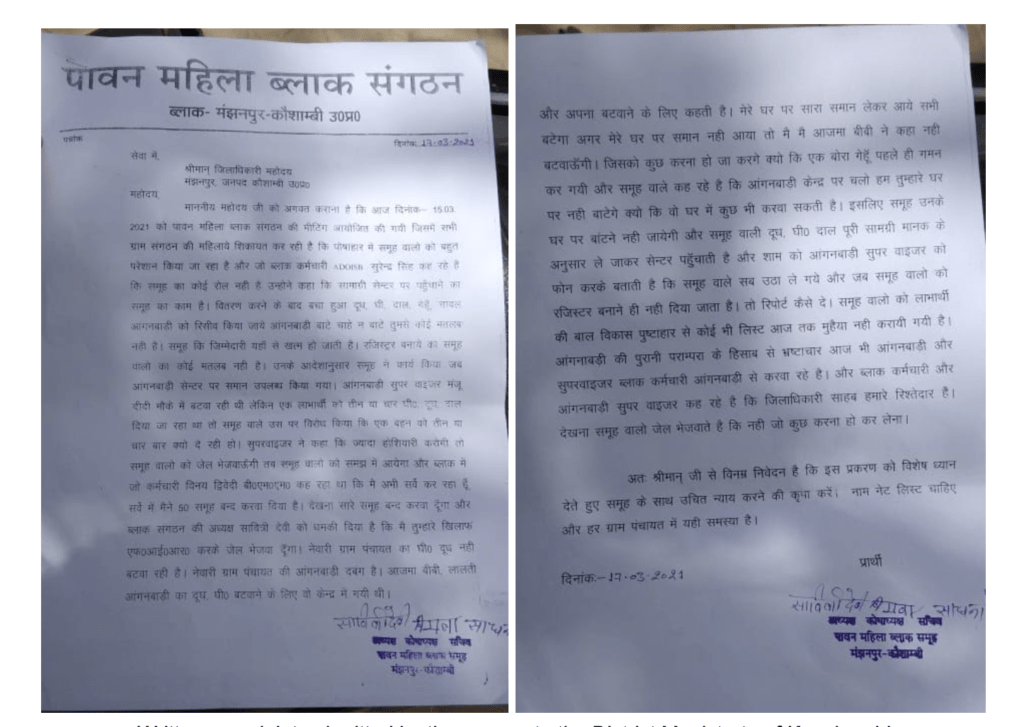
The CDPO Manju, on the other hand, claims that there is no issue in ration distribution. “We provide the self-help group members and Anganwadi workers with the ration, who then distribute it to the beneficiaries. There is no issue whatsoever,” she says.
Several women from Newari Gram Panchayat confirm that they haven’t received any ration. “We are eligible for the scheme but have not been given anything“, says Kalawati from Newari village and Gram Panchayat. Seema, from the same village and Gram Panchayat, also confirms that she hasn’t received any ration.
Sharmili, an ASHA worker from Bhaila Makdumpur Gram Panchayat shares, “Proper nutrition is essential for pregnant women and newborn children. The ration provided by the government helps ensure improvement in children’s weight and overall health and development of both mother and child.”
Similar story in Maharajganj
The issue of transparency in the distribution of ration extends to other districts as well. On 15th March 2021, Anganwadi workers and members of women’s self-help groups from Ghughli block in Maharajganj went to the Child Development office. They met the Chief Development Officer (CDO) Gaurav Singh Sogarwal who was on a surprise visit.
“Packets of dry ration are to be prepared by self-help group members in the Anganwadi Kendras and made available at the scheduled time, while synthetic milk and ghee are delivered to the Anganwadi Kendra. We are asked to sign the receiving but we are not given the material, we don’t know how much ration came and how much was distributed,” says Shakuntala Devi from Vishunpur Ghat village in Aahiruli Gram Panchayat.
“The ration distribution should be done either through the Anganwadi workers or the self-help group to ensure transparency,” chimes in Sunita Devi from Parsuni Bujurag village and Gram Panchayat.
After hearing their complaints, the CDO agreed that if the ration distribution is meant to be done through the self-help group they should get the materials and oversee the process.
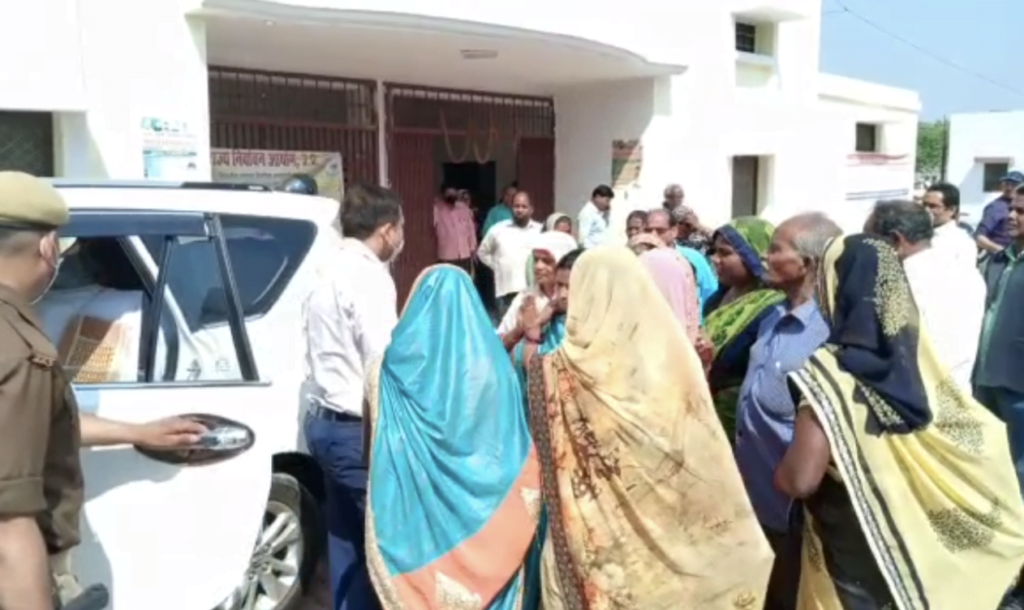
However, the Ghughli block Child Development Project Officer (CDPO) Soni Devi has refuted the allegations of lack of transparency in the process, stating that the distribution takes place in the Gram Sabha in front of everyone.
In February 2019, the Supreme Court division bench of Justice Arun Mishra and Justice Deepak Gupta while hearing Vaishnorani Mahila Bachhat Gat versus State of Maharashtra case had recommended that distribution of rations should be decentralised from district to panchayat or block-level to ensure proper supply.
Ila Reddy is a Delhi-based writer. Ground-reporting support by Ravi Singh and Sunita Devi. Follow her on Twitter, Instagram and her blog.
All images courtesy the author


